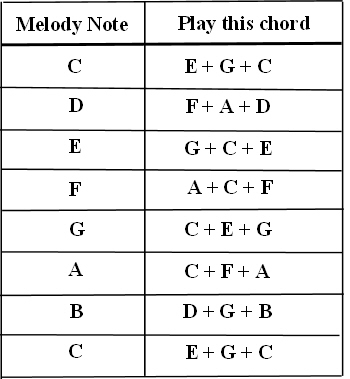Here is a late Christmas/New Year Present for you all.
Harmonising melodies is different from playing chords beneath a melody.
You may have heard of fake books and chord charts where you are given chords to play, generally above the melody line.
For example, the chord chart may display a “Cmaj7” over a particular bar with a melody line beneath it. You have to know how to read sheet music to some extent, to at least read the melody line.
Harmonising melodies is easier.
So, let us use “Mary had a little lamb”, as an example, because surely everyone knows this nursery rhyme, and it is easier to make this method clear with a simple song like this.
With this method, if you can sit at your AR and pick out the one-note melody, then you are very close to playing it as a full-sounding song. Why?
Because the
chords that harmonize notes NEVER change — only the notes themselves.
So if there are 8 notes in a major scale (really only 7 unique notes because the octave note makes

— and if you know the “matching” chord for each one of those notes, then you have what it takes to play full-sounding chords in place of your one-note melodies.
Let me explain…
Say, after a few minutes at the organ, you’ve managed to learn “Mary had a little lamb” and believe me, it’s not that hard to pick out a melody — even very young children can do it if you leave them at a keyboard long enough. It is certainly not rocket science.
I believe everyone has the ear to sit down and pick out a melody (especially if you know your major scales because most melodies come directly from the scales).
So if you can pick out a single note melody on your keyboard, now how can you easily harmonize this or any other melody?
Below you will find a Harmonisation Chart (for the Key of C). But first, here are some basic rules to keep in mind:
1. Every note in a major scale has its own harmonising chord
2. Whenever a note is played, simply replace it with its relevant harmonising chord
3. When all one-note melodies have been replaced with harmonizing chords, you have a full-sounding basic song.
Let’s take the
C major scale (but bear in mind that every major scale has its
own set of unique harmonising chords)

The three notes listed in the second column, must obviously all be played together, and at once, so that they form a chord
Do you notice anything unique about these harmonizing chords?
If you look carefully, you will see that the
highest note of the chord
always matches the melody note.
In essence, since you are replacing a melody note with a chord, in most cases, you’ll still want to preserve the melody, and as you will always want to hear the melody clearly, then by playing these particular chords, the
highest note of each chord IS ALWAYS THE MELODY.
Further analysis reveals that we have
1 C major chord, with 2 inversions (plus one of these is duplicated for the octave)
2 inversions of the F major chord
1 inversion of the D minor chord
and
1 inversion of the G major chord
So, all you have to do is take your melody and replace the individual notes with the appropriate chords.
For an example, I have copied the melody below, to “Mary had a little lamb” so that you can try it on your own.
Mary had a little lamb
I have completed the first line
E D C D E E E (Ma-ry had a lit-tle lamb)
_____________________________________
G+C+E (Ma) C - 2nd inversion
F+A+D (ry) Dm - 1st inversion
E+G+C (had) C - 1st inversion
F+A+D (a) Dm - 1st inversion
G+C+E (lit) C - 2nd inversion
G+C+E (tle) C - 2nd inversion
G+C+E (lamb) C - 2nd inversion
Notice that the original melody note is still on top! That’s the whole point of using the harmonizing chart created for you above. The song still sounds like “Mary had a little lamb”, the melody is still obvious, but with the addition of full-sounding harmony!
You can fill in the rest.
D D D (lit-tle lamb)
_____________________________________
________ (lit)
________ (tle)
________ (lamb)
E G G (lit-tle lamb)
_____________________________________
________ (lit)
________ (tle)
________ (lamb)
E D C D E E E E (Ma-ry had a lit-tle lamb, its)
______________________________________
________ (Ma)
________ (ry)
________ (had)
________ (a)
________ (lit)
________ (tle)
________ (lamb)
________ (its)
D D E D C (fleece was white as snow)
______________________________________
________ (fleece)
________ (was)
________ (white)
________ (as)
________ (snow)
If you’ve chosen the right harmonizing chords, then you should have a nice full-sounding arrangement of Mary had a little lamb above. If not, just try it again until it works.
So, you now have a simple method to harmonise any song.
1) Determine a melody to any song
2) Replace the melody notes with harmonizing chords making sure to keep the melody note as the highest tone of each chord (see chart above)
3) Add the bass (Either on the pedals or with your left hand)
Please feel free to comment if you found this helpful.
Peter